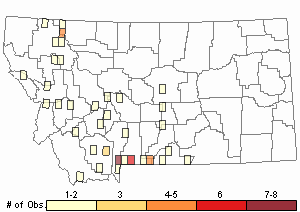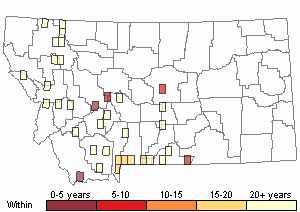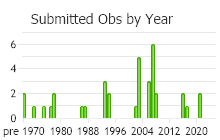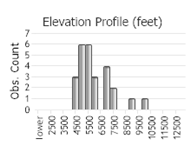View in other NatureServe Network Field Guides
NatureServe
Montana
Utah
Wyoming
Idaho
Wisconsin
British Columbia
South Carolina
Yukon
California
New York
Revolute Hypnum Moss - Hypnum revolutum
Other Names:
A Fern Moss
General Description
Plants: Pleurocarpous (Vitt 1988), growing in interwoven mats (Lawton 1971) or tufts (Crum and Anderson et al. 1981), russet, somewhat yellow, sometimes deep green (FNA 2014), green with brown tones, or more brown (Lawton 1971). Stems upright or nearly so, or prostrate, pinnate or erratically so, 2-5 cm, green with yellow tones; branches 2-7 mm in length; hyalodermis wanting and central strand not fully formed; pseudoparaphyllia leafy (FNA 2014); cortical stem cells tiny and with thick walls (Lawton 1971).
Leaves: Stem leaves straight to curved in sickle-like fashion and turned in one direction, 0.5-1.8 mm in length, to 0.6 mm in width (FNA 2014), cupped (Lawton 1971), sometimes pleated, egg-shaped to widely oblong with ovate tendencies, slowly tapering to the slender acumen, the base not extending down the stem nor lobed; leaf edges rolled back and downward from the bottom sometimes almost to the leaf tip, smooth distally; costa paired and conspicuous to seldom wanting; branch leaves akin to stem leaves except a little smaller (FNA 2014).
Leaf Cells: Laminal cells diamond-shaped and very thin (Crum and Anderson et al. 1981), not papillose; medial laminal cells narrower (FNA 2014) and longer than the basal cells, the walls a little thickened (Lawton 1971), nonporose; basal laminal cells occasionally somewhat yellow, with porose walls; alar cells uncolored, nearly square, the area not precisely delineated nor concave, extending 8-15 cells along the margin, with 2-3 bigger, oblong cells at the bottom marginal corner (FNA 2014).
Hypnum revolutum var. revolutum: Stems 3-5 cm in length; leaves pleated; leaf edges tightly rolled back and downward from the leaf bottom nearly to the apex; costa conspicuous (FNA 2014).
Hypnum revolutum var. ravaudii: Present in Montana. Stems mostly 2-3 cm in length, seldom reaching 5 cm, with broad, leafy paraphyllia; leaves not pleated; leaf edges flat or sometimes rolled tightly back and downward near the bottom; costa somewhat obscure (FNA 2014).
Phenology
Fruit ripens in summer (FNA 2014).
Diagnostic Characteristics
Prostrate plants of Hypnum revolutum are usually pinnate, and occasionally somewhat densely spaced. Plants growing more upright are usually more freely branched and distantly spaced (FNA 2014).
Plants of the similar H. recurvatum have paraphyllia slender and lance-shaped or consisting of filaments. They also have leaves strongly curved to tips coiled nearly in a circle; Hypnum revolutum var. ravaudii plants have broad, leafy paraphyllia and leaves that are often only a little curved and occasionally even straight (FNA 2014).
Range Comments
Montana Range
Hypnum revolutum: Known in Beaverhead, Broadwater, Carbon, Fergus, Flathead, Gallatin, Glacier, Golden Valley, Granite, Lake, Madison, Meagher, Mineral, Missoula, Park, Ravalli, Sweet Grass, and Valley Counties (Elliott and Pipp 2016). Cannot assume variety revolutum.
Hypnum revolutum var. ravaudii: Known in Glacier County (Elliott and Pipp 2016).
North American Range
Variety revolutum: AK to NU, BC to QC, also NL and NS, MT to NM and west from that line to the coastal states, also SD and TX (FNA 2014).
Variety ravaudii: BC and AB, CO (FNA 2014).
Observations in Montana Natural Heritage Program Database
Number of Observations: 71
(Click on the following maps and charts to see full sized version)
Map Help and Descriptions
Relative Density

Recency



 (Observations spanning multiple months or years are excluded from time charts)
(Observations spanning multiple months or years are excluded from time charts)
Habitat
Variety revolutum: Open areas, soil, stone, bottoms of trees, rotting logs, frequently but not always on calcareous surfaces. Occurring from lowlands to high elevations (FNA 2014).
Variety ravaudii: Open areas, soil, stone, bottoms of trees, rotting logs. Occurring from medium to high elevations (FNA 2014).
Reproductive Characteristics
Dioicous, with female and male plants resembling each other (FNA 2014). Perichaetia and perigonia occurring on the stems (Lawton 1971). Exterior perichaetial bracts bent back and downward; interior perichaetial bracts upright, pleated, with a thin, short, nearly smoothly-edged acumen and an obscure costa. Seta 10-20 mm tall, somewhat yellow, turning red with maturity, smooth. Capsule 2-3 mm in length, somewhat sordid yellow to brown, tilted to level (FNA 2014), bowed, frequently constricted below the opening when dry (Lawton 1971); operculum cone-shaped; exostome teeth 16, with a zigzag line on the outer face, fine lines or ridges below, and papillae above; endostome processes 16, similar in height as the teeth, keeled, cilia present. Calyptra hairless and draping hood-like (FNA 2014).
Stewardship Responsibility
References
- Literature Cited AboveLegend:
 View Online Publication
View Online Publication Crum, H.A. and L.E. Anderson. 1981. Mosses of Eastern North America. 2 volumes. Columbia University Press, New York. 1328 pp.
Crum, H.A. and L.E. Anderson. 1981. Mosses of Eastern North America. 2 volumes. Columbia University Press, New York. 1328 pp. Elliott, J.C. and A.K. Pipp. 2018. A Checklist of Montana Mosses (1880-2018). Updated 3 January, 2020. Montana Natural Heritage Program, Helena, Montana. 73 pp.
Elliott, J.C. and A.K. Pipp. 2018. A Checklist of Montana Mosses (1880-2018). Updated 3 January, 2020. Montana Natural Heritage Program, Helena, Montana. 73 pp. Flora of North America Editorial Committee, eds. 2014. Flora of North America North of Mexico. Volume 28. Bryophytes: Mosses, Part 2. Oxford University Press, Inc., NY. xxi + 702 pp.
Flora of North America Editorial Committee, eds. 2014. Flora of North America North of Mexico. Volume 28. Bryophytes: Mosses, Part 2. Oxford University Press, Inc., NY. xxi + 702 pp. Lawton, E. 1971. Moss Flora of the Pacific Northwest. Hattori Botanical Laboratory. Japan: Yamabuki-cho, Shinjuku-ku, Tokyo. 362 pages plus appendices.
Lawton, E. 1971. Moss Flora of the Pacific Northwest. Hattori Botanical Laboratory. Japan: Yamabuki-cho, Shinjuku-ku, Tokyo. 362 pages plus appendices. Vitt, D. J. Marsh, and R. Bovey. 1988. Mosses, Lichens & Ferns of Northwest North America. Seattle, WA: University of Washington Press. 296 p.
Vitt, D. J. Marsh, and R. Bovey. 1988. Mosses, Lichens & Ferns of Northwest North America. Seattle, WA: University of Washington Press. 296 p.
- Additional ReferencesLegend:
 View Online Publication
View Online Publication
Do you know of a citation we're missing? Aho, Ken Andrew. 2006. Alpine and Cliff Ecosystems in the North-Central Rocky Mountains. Ph.D. Dissertation. Bozeman, Montana: Montana State University. 343 p.
Aho, Ken Andrew. 2006. Alpine and Cliff Ecosystems in the North-Central Rocky Mountains. Ph.D. Dissertation. Bozeman, Montana: Montana State University. 343 p. Elliot, J. C. 1993. Second checklist of Montana mosses. Unpublished report. U.S. Forest Service, Region 1. Missoula, MT. 45 pp.
Elliot, J. C. 1993. Second checklist of Montana mosses. Unpublished report. U.S. Forest Service, Region 1. Missoula, MT. 45 pp. Flowers, S. 1973. Mosses: Utah and the West. Brigham Young University, Provo, Utah. 567 p.
Flowers, S. 1973. Mosses: Utah and the West. Brigham Young University, Provo, Utah. 567 p. Lawton, E. 1971. Keys for the Identification of the Mosses on the Pacific Northwest. Reprinted from 'Moss Flora of the Pacific Northwest'. Published as Supplement No. 2 of the Journal of the Hattori Botanical Laboratory. Nichinan, Miyazaki, Japan. 66 pp.
Lawton, E. 1971. Keys for the Identification of the Mosses on the Pacific Northwest. Reprinted from 'Moss Flora of the Pacific Northwest'. Published as Supplement No. 2 of the Journal of the Hattori Botanical Laboratory. Nichinan, Miyazaki, Japan. 66 pp. Malcolm, B., N. Malcolm, J. Shevock, and D. Norris. 2009. California Mosses. Nelson, New Zealand: Micro-Optics Press. 430 pp.
Malcolm, B., N. Malcolm, J. Shevock, and D. Norris. 2009. California Mosses. Nelson, New Zealand: Micro-Optics Press. 430 pp. Smith, A.J.E. 1980. The Moss Flora of Britain and Ireland. Cambridge University Press, Cambridge. 705 pp.
Smith, A.J.E. 1980. The Moss Flora of Britain and Ireland. Cambridge University Press, Cambridge. 705 pp.
- Web Search Engines for Articles on "Revolute Hypnum Moss"





